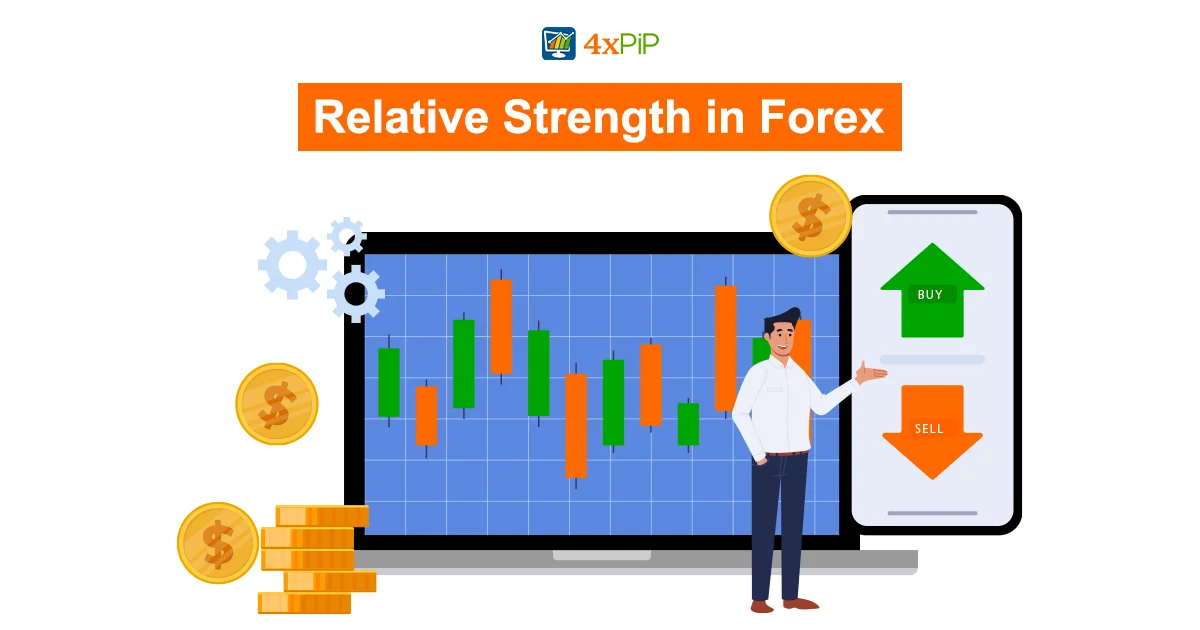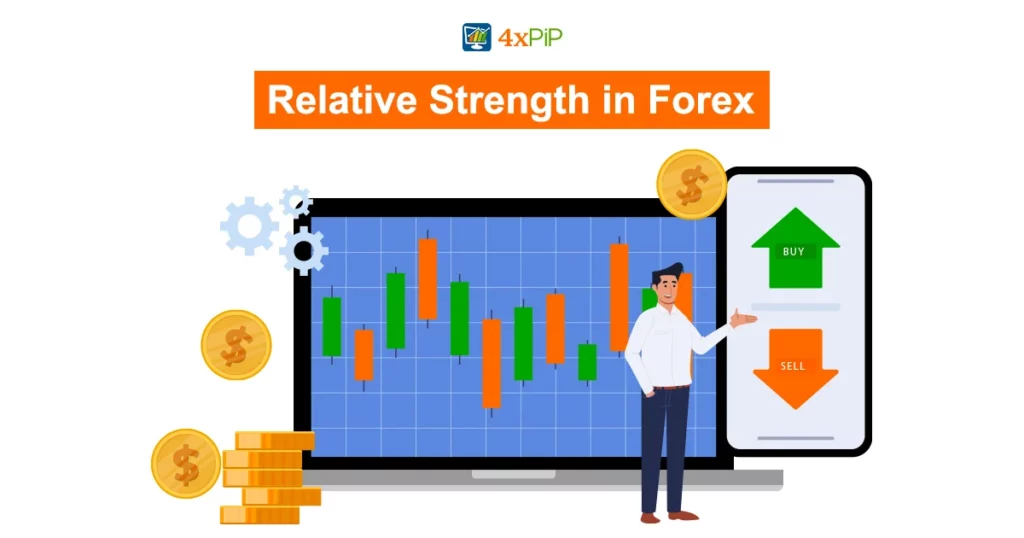In the world of forex trading, understanding relative strength is crucial for traders, both seasoned and newcomers. Additionally, this fundamental concept provides invaluable insights into the ever-changing dynamics of the market. In this article, we’ll delve into the significance of relative strength across forex, stocks, and cryptocurrencies. Moreover, this information will empower you with the knowledge you need for informed trading decisions.
If you have any questions or need guidance along the way, don’t hesitate to reach out to us at [email protected]. We’re here to assist you on your trading journey. Let’s now explore the world of relative strength and how it can enhance your trading skills.
The Concept of Relative Strength:
The concept of relative strength is a cornerstone in the world of forex, stock trading, and cryptocurrencies. Understanding this idea is like having a compass that guides your investment decisions. Relative strength, in essence, gauges the performance of one financial instrument in comparison to another, helping traders identify potential trends and make informed choices. Let’s explore this crucial concept further to empower your trading endeavors.
Key Points
- What Is Relative Strength? Relative strength measures the performance of one asset compared to another. In trading, it typically involves assessing the performance of one currency pair, stock, or cryptocurrency relative to another.
- Identifying Outperformers: Traders use relative strength to identify assets that are outperforming their peers. This can signal potential investment opportunities or trends in the market.
- Comparing Asset Classes: It’s not limited to forex; relative strength can be applied to stocks and cryptocurrencies, allowing traders to compare the performance of different asset classes.
- Technical Analysis Tool: Relative strength is often used in technical analysis. It involves comparing the price movements of two assets to find potential patterns or trends.
- Risk Management: By understanding relative strength, traders can make more informed decisions regarding risk management, helping to minimize losses and maximize gains.
- 4xPip Assistance: For further guidance or tools related to relative strength and trading, feel free to reach out to our experts at [email protected].
Mastering Relative Strength:
Understanding relative strength is a valuable skill that can significantly enhance your trading strategies across various financial markets.
Mastering the concept of relative strength is akin to unlocking the hidden potential of your trading endeavors. It’s a skill that can set you apart as a trader, whether you’re delving into forex, stocks, or cryptocurrencies. To truly master relative strength, it’s crucial to understand not only the theory behind it but also how to apply it effectively in your trading strategies.
Understanding Relative Strength:
Relative strength in trading is about discerning which financial instruments are performing better compared to others. This means identifying the outliers, those assets that are displaying stronger trends or more robust price movements. To master this concept, it’s essential to grasp the significance of relative strength in various trading scenarios.
Practical Application:
Mastering relative strength goes beyond theoretical knowledge; it’s about using it as a practical tool. Additionally, by comparing the performance of different currency pairs, stocks, or cryptocurrencies, traders can identify trends and make decisions that can lead to profitable outcomes. This involves scrutinizing price charts and applying technical analysis. Moreover, it helps find the assets that are showing consistent strength or weakness.
Risk Management and Strategy:
One of the key benefits of mastering relative strength is effective risk management. Additionally, by identifying assets that are likely to continue their trends, traders can make more informed decisions about entry and exit points. This can be a game-changer in reducing potential losses. Moreover, it optimizes gains by aligning strategies with ongoing market dynamics.
The Significance of Relative Strength in Diverse Markets:
Relative strength isn’t just a concept that applies to one specific market; it holds significance across various financial landscapes. Whether you’re an avid forex trader, a stock market enthusiast, or intrigued by the cryptocurrency boom, understanding and applying relative strength can be a game-changer in all these arenas.
In the world of forex, relative strength is an essential tool for currency traders. It enables you to compare the performance of different currency pairs, helping you identify which ones are likely to continue their trends. This insight is invaluable in making informed trading decisions and managing risk effectively. Similarly, stock traders use relative strength to assess the performance of different stocks within a sector or market index. By pinpointing the strongest contenders, you can optimize your stock portfolio and potentially enjoy better returns. Cryptocurrency enthusiasts also find relative strength analysis useful in identifying the top-performing digital assets and making strategic investment choices.
Using Relative Strength in Trading:
When it comes to trading in the financial markets, relative strength is a concept that can be a game-changer. In this section, we’ll delve into effective strategies for harnessing the power of relative strength to make better trading decisions. Whether you’re trading forex, stocks, or cryptocurrencies, these strategies can help you navigate the markets with confidence and competence.
Identifying Strong Trends: One effective strategy is to use relative strength to identify strong trends. When an asset shows consistent strength compared to others, it’s often a sign that a trend is in motion. This can guide you in making timely entries and exits.
Risk Management: Another key strategy is using relative strength to manage risk. By knowing when an asset is overbought (potentially due for a price correction) or oversold (potentially due for a rebound), you can set stop-loss and take-profit levels more effectively.
Combining with Other Indicators: Consider combining relative strength with other technical indicators for a more comprehensive trading strategy. This can provide a deeper understanding of market conditions and potential price movements.
Different Timeframes: Experiment with using relative strength on different timeframes. Short-term traders may benefit from a faster RSI setting, while longer-term investors might prefer a more extended timeframe to capture broader market trends.
Effective strategies for using relative strength can be the key to making informed trading decisions and achieving your financial goals in the dynamic world of trading.
Relative Strength Index (RSI):
The Relative Strength Index (RSI) is a powerful and widely used technical indicator that plays a significant role in the world of trading, particularly in forex, stocks, and cryptocurrencies. The RSI is a momentum oscillator that compares the magnitude of recent gains to recent losses. A scale of 0 to 100 typically displays it as an oscillating line. Analysts calculate the RSI value by considering the closing prices of an asset over a specified period, commonly 14 periods. Here’s how RSI works:
- RSI values above 70 suggest that the asset may be overbought, indicating a potential reversal or correction.
- RSI values below 30 suggest that the asset may be oversold, signaling a potential opportunity for a price rebound.
Applications of RSI:
RSI has various practical applications in trading, which can be beneficial for traders in different markets. These applications include:
- Identifying Overbought and Oversold Conditions: RSI helps traders spot when an asset is overbought (potentially due for a price decline) or oversold (potentially due for a price increase).
- Divergence Analysis: Traders use RSI to identify divergences between the RSI indicator and the price chart, which can indicate potential reversals.
- Confirmation of Trends: RSI can be used to confirm the strength of trends. If an asset is trending higher and the RSI remains above 70, it indicates a strong bullish trend.
- 4xPip Service: When working with the popular trading platforms MetaTrader 4 (MT4) or MetaTrader 5 (MT5), you can easily access RSI indicators. For MT4, use the RSI indicator under “Indicators” in the Navigator window. In MT5, the RSI indicator is available in the “Indicators” section. This tool can be invaluable in your trading strategy to make informed decisions.
At 4xPip, we understand the significance of the Relative Strength Index (RSI) in trading, which is why we offer tools to enhance your trading experience. For those using the popular MetaTrader 4 platform, our improved RSI indicator can provide you with invaluable insights into overbought and oversold conditions. Additionally, if you prefer MetaTrader 5, our team has designed the MT5 RSI EA (Expert Advisor) to enhance accessibility and efficiency in RSI-based trading strategies. In MetaTrader 4, our MT4 RSI EA can help you automate your trading decisions based on RSI signals. These tools can be essential in maximizing the benefits of the RSI indicator and streamlining your trading process.
Summary:
In this blog, we’ve covered the concept of relative strength in forex trading and its wide-ranging applications in various financial markets. Additionally, it serves as a guide to pinpoint assets that are performing exceptionally well and helps you manage risks more effectively. Moreover, we’ve discussed the importance of mastering relative strength, emphasizing its practical utility in diverse trading scenarios. Furthermore, it empowers traders to make more informed decisions regarding their investments.
We’ve introduced you to the Relative Strength Index (RSI), a valuable tool for traders in different markets. Additionally, RSI provides insights into overbought and oversold conditions. Moreover, it’s readily accessible through platforms like MetaTrader 4 (MT4) and MetaTrader 5 (MT5). Furthermore, this accessibility enables you to enhance your trading strategies and make informed decisions across various financial markets.












